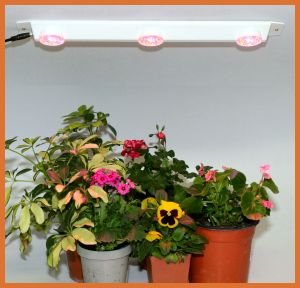Here is a very small list of wavelengths (nm) that can be used for selecting LEDs when building your own LED Grow Lights or Solid State Plant Lighting:
200 - 280 nm UVC ultraviolet range which is generally harmful to plants. LEDs in this spectrum are non-existant or very expensive.
280 - 315 nm Includes harmful UVB ultraviolet light which causes plants colors to fade. UV LEDs in this range are now available and coming down in price.
315 - 380 nm Range of UVA ultraviolet light which is neither harmful nor beneficial to most plants.
380 - 400 nm Start of visible light spectrum. Process of chlorophyll absorption begins. UV protected plastics ideally block out any light below this range.
400 - 520 nm This range includes violet, blue, and green bands. Peak absorption by chlorophyll occurs, and a strong influence on photosynthesis. (promotes vegetative growth)
520 - 610 nm This range includes the green, yellow, and orange bands and has less absorption by pigments.
610 - 720 nm This is the red band. Large amount of absorption by chlorophyll occurs, and most significant influence on photosynthesis. (promotes flowering and budding)
720 - 1000 nm There is little absorption by Chlorophyll here, but Phytochrome uses a nice portion. Flowering and germination is influenced. Near and above the higher end of the band is the Infrared spectrum, which can also be heat and could cause elongation or affect water absorption/transpiration.
The ratio of red (660nm) to far red (730nm) in sunlight is about 1.2:1
Many of these plant pigments have dual wavelength peaks that can be activated with led light combinations:
Beta-carotene 450nm 480-485nm dual peak
chlorophyll a 430nm 662nm dual peak
chlorophyll b 453nm 642nm dual peak
phycoerythrin 590nm single peak
phycocyanin 625nm single peak
670nm and 700nm for the Emerson effect.
http://www.biologie.uni-hamburg.de/b-online/e24/12.htm
Wavelength and Pigment Absorption image below borrowed from http://www.estrellamountain.edu/faculty/farabee/biobk/pigment.gif
If you have additional information that you feel that could help other LED Grow Light researchers and should be added please send it to: ledgrowlights[remove extra stuff and brackets](@ googles)gmail.com
Wavelengths in LED Plant Grow Lights
Posted by
Led Grow Lights
0
Led Grow Light comments
![]()
Subscribe to:
Comments (Atom)



